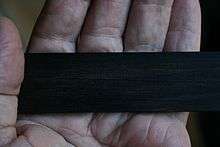Diospyros crassiflora
| Diospyros crassiflora | |
|---|---|
 | |
| Scientific classification | |
| Kingdom: | Plantae |
| (unranked): | Angiosperms |
| (unranked): | Eudicots |
| (unranked): | Asterids |
| Order: | Ericales |
| Family: | Ebenaceae |
| Genus: | Diospyros |
| Species: | D. crassiflora |
| Binomial name | |
| Diospyros crassiflora Hiern | |
Diospyros crassiflora, commonly known as Gabon ebony, African ebony, West African ebony, and Benin ebony,[1] is a species of lowland-rainforest tree in the family Ebenaceae that is endemic to Western Africa. It is named after the West African state of Gabon, though it also occurs in Cameroon, Central African Republic, Republic of the Congo, Democratic Republic of the Congo and Nigeria.
The wood this particular tree produces is believed to be the blackest of all timber-producing Diospyros species, and the heartwood from this tree has been in extremely high demand since ancient Egyptian times.[2] It is hard and durable with very fine pores, and it polishes to a high luster. It is used to make sculptures, carvings, pool cues, doorknobs, tool and knife handles, gun grips, the black keys on pianos, organ-stops, guitar fingerboards and bridges, and chess pieces. It is the wood of choice for the fingerboards, tailpieces, and tuning pegs used on all orchestral stringed instruments, including violins, violas, cellos, and double basses.
Because of its desirable qualities, the wood is overexploited. The largest trees of this species have been harvested, except perhaps those growing in the most remote parts of its range. The International Union for Conservation of Nature classifies it as an endangered species.[3]
References
- ↑ Diospyros crassiflora. Plant Resources of Tropical Africa.
- ↑ Nesbitt, M. The Cultural History of Plants. Routledge, New York-London, 2005. pg. 321.
- ↑ African Regional Workshop (Conservation & Sustainable Management of Trees, Zimbabwe, July 1996). 1998. Diospyros crassiflora. In: IUCN 2013. IUCN Red List of Threatened Species. Version 2013.1. Downloaded on 24 July 2013.
